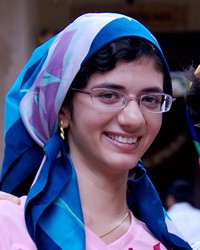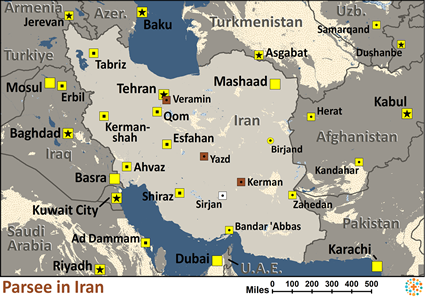The Parsees, or Parsis, trace their origin to the Persian Kings of the Old Testament including King Darius, Cyrus, and Xerxes who aided in the rebuilding of the Temple. In the Old Testament, Cyrus is noted as the only Gentile who was called "anointed." The magi who came to worship at Jesus' birth are also believed to have been Parsee. Because of their ancient heritage, which is dated at before 3000 BC, they are very proud and cling to their identity of royal heritage.
After the Muslim conquest of Iran in the 7th century, the majority of Parsees migrated over time to India in order to avoid religious persecution. Today, the majority of Parsees live in India, with significant numbers in Iran, the United States, Canada, and Pakistan and smaller communities in several other countries.
Though separated geographically, the Parsees who remained in Iran maintained close ties with the Parsees in India beginning in the 13th century. The Iranian Parsees sent several key religious texts to India for safekeeping. Parsees in India began seeking religious advice from the magi in Iran. Over the centuries, Parsee emissaries from India made multiple trips to Iran, living among the Iranian Parsees and being educated by them before returning to India. Iranian Parsees sent treatises on religious observances to their Indian counterparts between 1478 and 1773.
Parsees in diaspora communities have generally enjoyed success both economically and socially in professions including law, medicine and education. However, overall numbers of Parsees have declined in the last two centuries because of a combination of factors. Many Parsees defer marriage in favor of pursuing professional careers, which has lowered the birthrate. Additionally, many Parsee communities do not accept converts, limiting the communities to new births as the only means of increase. Finally, intermarriage with other sectarian groups has led to a drain on many communities.
Parsee communities are tightly knit closed groups. Most Parsee communities do not accept converts, and marriage outside the community often results in varying levels of rejection by the group. Parsee women who marry outside their people group lose their Parsee rights and privileges. Children of such marriages cannot participate in key religious rites and are ineligible for communal funds.
Parsees view themselves as superior to all other religious groups and races. Their restrictive practices regarding conversions and marriage, together with the increasing tendency to defer marriage in favor of professional careers, has resulted in declining numbers over the last couple of centuries.
Parsees in diaspora communities have generally enjoyed success both economically and socially in professions including law, medicine, and education. This emphasis on economic success has not only caused Parsees to marry later (resulting in smaller families) but has also led in some cases to a decline in enrollment in their madrasahs (seminaries).
While Indian Parsees speak primarily Gujarati, Parsees in Iran speak a combination of Parsi and Dari.
Parsees hold to Zoroastrianism. Zoroastrianism has fire as a symbol of the supreme deity. It represents the son of god. All religious rituals and rites of passage feature a burning fire, often lit by sandalwood and oil. Fires burn continuously in homes, and the temple fire is forbidden to burn out. Fire worship may include falling prostrate before the flames.
Zoroastrians believe in a Wise Creator god and value wisdom above all other character traits. They believe in guardian angels, whose primary purpose is to grant wishes. Conscience is the most important of such angels. They believe in salvation and resurrection, though they do not understand these concepts in the same way Christians do.
Zoroastrians practice ancestor worship. They pray and bow down to pictures of deceased loved ones in their homes. In August, they focus especially on ancestor worship and seek the forgiveness of their ancestors. Demons manifest themselves in the likeness of lost family members.
The Parsee people celebrate six seasonal festivals known as Gahambars. These five-day festivals feature worship dedicated to Ahura Mazda, followed by assemblies of feasting, fellowship and acts of goodwill.
Upon a baby's birth, mother and child are confined with a lamp to ward off demons. Children are often given three names: a personal name, the father's name, and the family name.
Zoroaster taught that there was only one God, who had a rival (similar to Satan in Christian belief). He taught that by doing good works, people could go align themselves with the good god, Ahura Mazda, and go to heaven. Today's Parsees hold to a code of conduct summarized as, "good thought, good word, good deeds." They give generously to the poor and needy. They believe they go to heaven by reading or reciting their Zoroastrian scriptures. Zoroastrian scriptures are the biggest and most difficult obstacle to their conversion to Christianity.
Parsees respect other faith systems and gods. The Bible is treated honorably as a religious text and Christ is also seen in a positive light and as a Messiah.
The Bible has been translated into Gujarati, the language of the majority of Parsees who live in India. The Dari language also has a complete translation of the Bible and translation work has begun in Parsi. However, the status of Bible translation into the Parsi-Dari language spoken by Iranian Parsees is not known.
Most Parsee communities are relatively well-educated and prosperous. A small minority community in Iran, they may suffer persecution from the larger Shia Muslim communities. Their beliefs parallel basic Christian beliefs in many ways; their primary need is for spiritual discernment to separate truth from error. They would likely respect and listen to a well-educated missionary who can return their respect while guiding them into truth.
Pray that God will give the Parsees a spiritual hunger to investigate the claims of Christ. Ask the Holy Spirit to give them spiritual discernment.
Ask God to send laborers from the growing Iranian church to the Parsees and to direct these laborers to persons of peace.
Pray that God will not let economic success be a barrier to the Parsees seeking Christ.
Ask God to raise up a disciple-making movement among the Parsees that will result in multiplying churches and disciples.
Scripture Prayers for the Parsee in Iran.
https://joshuaproject.net/people_groups/14322/IR
https://www.britannica.com/topic/Parsi
https://www.encyclopedia.com/philosophy-and-religion/eastern-religions/buddhism/parsis
| Profile Source: Joshua Project |


























